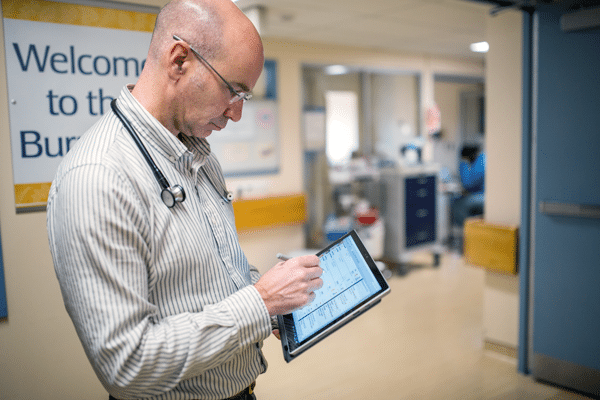The technology landscape has changed significantly since Mark Farrow joined Hamilton Health Sciences (HHS), a multicampus, academic teaching hospital in Ontario, Canada in 1999. “The system that we installed that helped make this a fully computerized, automated hospital had less horsepower than what I’ve got in my iPhone today,” Farrow says.
In the nearly two decades since he joined, Farrow, vice president and chief information officer, has implemented new systems across the organization; however, his budget has not grown accordingly. After optimizing contracts and increasing efficiency to adhere to budget cuts, the only thing left for Farrow to reduce was staff. But that was one sacrifice he wouldn’t make. “I’ve invested in this talent pool, and I really wasn’t willing to give that up and lay off people,” he says.
So instead of decreasing the department’s size, he transformed its approach.

His team reimagined itself from an IT department to Health Information Technology Services, an IT consulting and hosting service. With this rebrand, the team began taking on more clients. In addition to supporting HHS, Farrow’s group now offers hosting, security, application support, strategic planning, and other services to outside organizations. “We found that a lot of organizations that don’t have our depth and breadth can contract with us, they can get access to an entire department of skill sets,” Farrow says.
One program the organization implemented to aid in this transformation was ClinicalConnect, a clinician-facing portal that pulls together patient information from across Southwest Ontario in a single, easy-to-use platform, in real time. Farrow launched the program internally in 2007, with the goal of connecting patient information within HHS. The organization had previously stored information on a number of different systems, leading to dangerous miscommunications among the systems’ branches. By connecting patient information quickly and consistently, the program improved patient care across the organization.
As other hospitals in the area learned of the portal, they sought to connect it to their own system. Farrow saw how this could serve both the patients’ needs and his department’s. “Hamilton is a tertiary referral center. We have patients going back and forth, so they thought this would be a much better way to help get patients to us as well as repatriate patients back to their home hospitals,” he says. “The more that we can put the patient at the center and share that information, the better it is for the patient, and the easier it makes it for our clinicians. Access to good information is what healthcare is all about.”
ClinicalConnect works so effectively in part because the data is stored in the host systems, allowing individual organizations to securely share information with the platform while maintaining its system’s backend code. “We’ll treat any hospital’s host system as the source of truth, and we point to the source of truth,” Farrow explains. The only information that HHS stores is the patient’s registration information, which is used to create a pointer to the host system. “When you go in to call up the patient, you’re not having to go out and search all of the points where that patient could have been registered. We know where the patient is and we put the calls out only to those systems to grab the data back. It keeps that level of efficiency, but it’s not creating another repository,” he says.

In 2010, Farrow and his team began to roll ClinicalConnect out to other organizations. With funding from eHealth Ontario and Canada Health Infoway, they have scaled ClinicalConnect to include information from all acute care hospitals, Local Health Integration Networks’ Home & Community Care Services, and regional cancer programs in Southwest Ontario, as well as various provincial data repositories.
Now that the connections are in place, Farrow and his team have begun to implement a patient-facing portal, which will allow patients to access their data from across healthcare systems in one secure platform. The system will especially benefit patients with chronic diseases who might see multiple clinicians in various organizations, each with its own patient portal. “You don’t want to have to go into each one of those different portals and try to stitch the information together yourself,” Farrow says. “Where we’ve created the largest federated access on the clinician side, we plan to do the same thing on the patient side now. I think that is going to be a game changer for how we can interact with our patients within the province.”
Programs such as ClinicalConnect have allowed Farrow to grow his team, which now has more than one hundred members. Through consulting, the group learns how other organizations operate and works on a wider scope of responsibilities, as well as a wider scale. “It helps my team build their overall skill set, and I end up with a better workforce,” Farrow says. “My staff is happy because they’re being given opportunities that they might not have had, and my clients are happy because they’re getting healthcare professionals that are helping them move forward, and we can do it in a very cost-effective manner.”
Thinking of HHS as a client, rather than an employer, required Farrow’s team to shift its approach to its work, and this might be the biggest change of all. “It has made them take more ownership and be more focused on what they’re doing,” he says. “For me, it’s been a win across the board.”
ClinicalConnect is a comprehensive, fast, easy-to-use, and highly visible web-based enterprise solution that gives healthcare providers on-demand access to patient data enabling them to make informed diagnostic and treatment decisions. This patient priority system comes with highly customizable workflows designed to optimize access and performance to patient clinical data. ClinicalConnect is powered by the aptean ClinicalLink solution.

